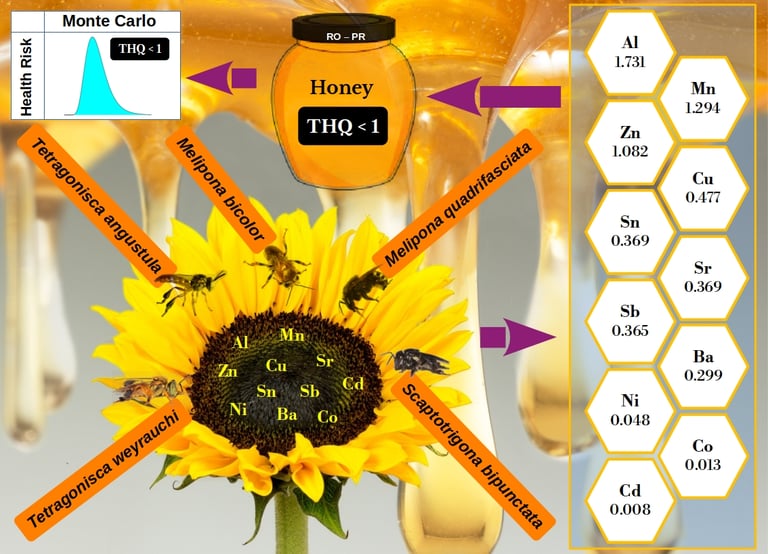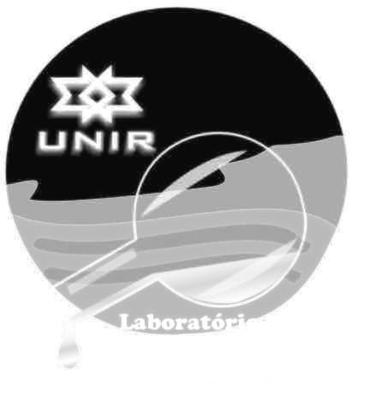Publicações 2025
Western Amazon, trace elements, Madeira River, Trace elements, Hazard quotient, Hazard index, Amazônia, Ecotoxicology, Environmental Impact, Environmental Law, Sedimentology, Terrestrial Pollution, Environmental Chemistry, Mercury Cycling, Health Effects, Se:Hg ratio, Biomagnification, Risk biomarkers, Toxicity, Food safety, Relationship between bee species and metal content in honey, Possibly the behavior of bees did not reflect the metal composition of honey samples, The area foraged by the bees influenced the variability of the trace elements, No possible health risk was detected due to lifetime honey consumption
ARTIGOS & PERIÓDICOS
Health risk due to the presence of trace elements in stingless bee honey consumed in the Amazon and Southern Brazil
Débora Francielly de Oliveira, Daniel José Nascimento Braga, Walkimar Aleixo Costa Júnior, Gabriel Henrique Abrantes Holanda, Ludimilla Ronqui, Rejane Stubs Parpinelli, Izidro Ferreira de Sousa-Filho, Mariangela Soares de Azevedo, Ronaldo de Almeida, Wanderley Rodrigues Bastos
Abstract:
The presence of some essential and non-essential trace elements in stingless bee honeys raises public health concerns, even though research evaluating these honeys is scarce. A comparison was made of the concentrations of 11 potentially toxic trace elements in honey samples from five stingless bee species collected in two states in Brazil. Trace elements were quantified by ICP-OES. The average concentrations (mg.kg⁻¹) of trace elements were: Al (1.728), Mn (1.301), Zn (1.071), Cu (0.471), Sn (0.372), Sr (0.366), Ba (0.299), Sb (0.245), Ni (0.047), Co (0.013) and Cd (0.008). The results indicated that honey from Paraná (South region) contained higher levels of Ba and Co, while honey from Rondônia (Amazon region,) had the highest concentration of Sb. The variation in the results may not be related to the bee species’ behaviors, but rather to their foraging territory to collect nectar/pollen and the type of plants and flowers visited. This observation allows considering honey as a good indicator for monitoring environmental contaminants. The results of the health risk assessment based on the consumption of the honey samples collected in the two evaluated states did not indicate carcinogenic risk due to lifetime consumption of the products.


Graphical Abstract:
A Novel Approach to Estimate Mercury Exposure Risks Through Fish Consumption Based on the Selenium–Mercury Molar Ratio
Cássio da Silva Cabral, Lucas Cabrera Monteiro, Thiago Aluisio Maciel Pereira, Walkimar Aleixo da Costa Júnior, Iuri Aparecida da Silva Oliveira, Thayson Araujo Canela, José Vicente Elias Bernardi, Inácio Abreu Pestana and Ronaldo de Almeida
Abstract:
In contrast to mercury, an extremely toxic element, selenium is an essential micronutrient, which by complexing with mercury can mitigate its toxicity. In this regard, we quantified mercury and selenium concentrations in samples (n = 309) of fish tissues and analyzed the Se:Hg molar ratio and HBVSe as toxicological risk biomarkers. The data indicated that mercury levels in planktivorous fish (0.630 ± 0.202 mg kg⁻¹) and carnivorous fish (1.196 ± 0.513 mg kg⁻¹) were above the Brazilian limits considered safe for daily consumption. The highest selenium concentrations were observed in planktivores (0.272 ± 0.093 mg kg⁻¹) and the lowest in herbivores (0.099 ± 0.092 mg kg⁻¹). Molar ratios greater than one and positive HBVSe values were found in 42% of the fish samples (n = 131). As a result, we found that (i) the trophic level influences the risk of mercury exposure through the intake of fish in the diet; (ii) the approach presented in our study (model II) involves greater rigor concerning intake and exposure via fish consumption, since it considers the antagonistic Se:Hg ratio; and (iii) selenium can attenuate mercury toxicity, but safe thresholds vary depending on the species.
Mercury Scenario in Fish from the Amazon Basin: Exploring the Interplay of Social Groups and Environmental Diversity
Thaís de Castro Paiva, Inácio Abreu Pestana, Lorena Nascimento Leite Miranda, Gabriel Oliveira de Carvalho, Wanderley Rodrigues Bastos and Daniele Kasper
Abstract:
The Amazon faces significant challenges related to mercury contamination, including naturally elevated concentrations and gold mining activities. Due to mercury’s toxicity and the importance of fish as a protein source for local populations, assessing mercury levels in regional fish is crucial. However, there are gaps in knowledge regarding mercury concentrations in many areas of the Amazon basin. This study aims to synthesize the existing literature on mercury concentrations in fish and the exposure of urban and traditional social groups through fish consumption. A systematic review (1990–2022) was conducted for six fish genera (Cichla spp., Hoplias spp. and Plagioscion spp., Leporinus spp., Semaprochilodus spp., and Schizodon spp.) in the Web of Science (Clarivate Analytics) and Scopus (Elsevier) databases. The database consisted of a total of 46 studies and 455 reports. The distribution of studies in the region was not homogeneous. The most studied regions were the Madeira River sub-basin, while the Paru–Jari basin had no studies. Risk deterministic and probabilistic assessments based on Joint FAO/WHO Expert Committee on Food Additives (JECFA, 2007) guidelines showed high risk exposure, especially for traditional communities. Carnivorous fish from lakes and hydroelectric reservoirs, as well as fish from black-water ecosystems, exhibited higher mercury concentrations. In the Amazon region, even if mercury levels in fish muscle do not exceed regulatory limits, the high fish consumption can still elevate health risks for local populations. Monitoring mercury levels across a broader range of fish species, including both carnivorous and non-carnivorous species, especially in communities heavily reliant on fish for their diet, will enable a more accurate risk assessment and provide an opportunity to recommend fish species with lower mercury exposure risk for human consumption. The present study emphasizes the need to protect regions that already exhibit higher levels of mercury—such as lakes, hydroelectric reservoirs, and black-water ecosystems—to ensure food safety and safeguard public health.
Combined effects of land use and geology on potentially toxic elements contamination in lacustrine sediments from the Araguaia River floodplain, Brazilian Savanna
Lucas Cabrera Monteiro, Ludgero Cardoso Galli Vieira, José Vicente Elias Bernardi, Thiago Aluisio Maciel Pereira, Walkimar Aleixo da Costa Júnior, Wesley Pinheiro da Silva, Leonardo Almeida Guerra dos Santos, José Francisco Gonçalves Júnior, João Carlos Nabout, José Alexandre Felizola Diniz Filho, Jeremie Garnier, Cleber Lopes Filomeno, Ronaldo de Almeida & Wanderley Rodrigues Bastos
Abstract:
Freshwater ecosystems play a fundamental role in maintaining biodiversity and supporting human societies; however, the mobilization of potentially toxic elements (PTEs) poses a significant threat to their integrity. Here, we characterized the elemental composition of the bottom sediments of 72 lakes in the Araguaia River floodplain, a region that has been undergoing large-scale environmental degradation due to the advance of anthropogenic activities. The objectives of this study were to assess the degree of Cr, Cu, Ni, Pb, and Zn contamination in bottom sediments, identify critically contaminated areas, and evaluate the contribution of anthropogenic and natural factors to the distribution of PTEs in the floodplain. The contamination and enrichment factors followed the order of Ni > Cr > Pb > Cu > Zn. Notably, Ni and Cr showed the highest proportions of samples with moderate and significant enrichment, respectively, with a considerable and very high degree of contamination. Critical areas of PTE contamination have been identified in lakes with intense anthropogenic land use and igneous and metamorphic rocks derived from mafic parent materials. All PTEs were strongly correlated with the Mg concentrations in the sediments, which were used here as a proxy for regional geology characterization. Land-use intensity was positively associated with higher Cr and Ni concentrations in sediments. Organic matter content significantly influenced the accumulation of PTEs in sediments (except for Cr). This study offers valuable insights into the sources, distribution, and control of PTE contamination in floodplain lakes, underscoring the importance of sustainable land use management in mitigating contamination risks.
Assessment of risk to human health associated with the consumption of contaminated groundwater in the Western Brazilian Amazon
Josilena de Jesus Laureano, Elisabete Lourdes do Nascimento, Caryne Ferreira Ramos, Daíse da Silva Lopes, Luiza Fernanda Silva Pavanello, Tiago de Oliveira Lima, Alan Gomes Mendonça, Ana Lúcia Denardin da Rosa, Walkimar Aleixo da Costa Junior, Maria Cristina N. do N. Recktenvald & Wanderley Rodrigues Bastos
Abstract:
The present study evaluates the risk to human health associated with the consumption of groundwater in municipalities in the Western Brazilian Amazon (Jaru, Ouro Preto do Oeste, Ji-Paraná and Presidente Médici, all in the state of Rondônia). Water was collected directly from wells with an underground collector and PET bottles between 2017 and 2019, in periods (low water, high water, Transition high water/low water). Nitrite and nitrate analyses were carried out using spectrophotometry (APHA, Standard methods for the examination of water and wastewater, Washington, 2017; EPA, Technical Resource Document, EPA/600/4-79/020 Disponívelem, 1971). Trace elements were detected by inductively coupled plasma-optical emission spectrometry. The hazard quotient was obtained from the ratio between the exposure level and the acceptable level for each substance present in the samples, and the hazard index resulted from the sum of the hazard quotients found for each substance. We found that the groundwater in the study areas is improper for human consumption in accordance with Brazilian regulations. Concentrations were found above the maximum values permitted by the Edict on Potability of Water for Human Consumption (PRC Edict 5/2017, as amended by GM/MS Edict 888/2021), and the World health organization standard for 2017 for Al (< 200 µg L⁻¹), As (< 10 µg L⁻¹), Ba (< 700 µg L⁻¹), Fe (< 300 µg L⁻¹), Mn (< 100 µg L⁻¹), Pb (< 10 µg L⁻¹), Zn (< 5,000 µg L⁻¹), and nitrate (< 10,000 µg L⁻¹). The results of the risk assessment indicated that the values were above the recommended levels (< 1) in 75.3% of the samples analyzed, meaning that people in the areas studied are highly exposed to contaminants that are harmful to human health.
Seasonal dynamics of trace elements in water and sediments (suspension and bottom) in the Madeira River Basin, Western Amazon
Walkimar Aleixo da Costa-Júnior, Ronaldo de Almeida, Izidro Ferreira de Sousa-Filho, Dario Pires de Carvalho, Luiz Drude de Lacerda & Wanderley Rodrigues Bastos
Abstract:
Trace elements are ubiquitous global pollutants in modern society and are present in water and biota associated with natural and anthropogenic sources. In this context, this study reports the dynamics of trace elements in the Upper Madeira River Basin, a region that has undergone major environmental changes in the past decades, such as deforestation, mining, and the installation of two large hydroelectric power plants. Bottom sediment, water, and suspended particulate matter (SPM) were collected to determine water quality parameters and trace elements concentrations, quantified by ICP-OES. The average electrical conductivity of water was higher in the Madeira River (110.6 ± 44.4 µS cm⁻¹) than in its tributaries (59.0 ± 49.1 µS cm⁻¹). The Madeira River water has a pH close to neutral (7.0 ± 0.8), compared to the slightly acidic water of the tributaries (6.3 ± 0.9). The average dissolved oxygen in the Madeira River water samples was 6.9 mg L⁻¹, significantly higher than in the tributaries (3.9 mg L⁻¹). The sediment from the Madeira River has higher concentrations of As, Cu, Mn, Ni, Sr, and Zn than the tributaries but lower concentrations of Ba, Mn, Pb, Sr, V, and Zn in the SPM. Trace elements concentrations in the SPM remained relatively constant during the study period and were controlled by seasonality. The average concentrations of trace elements in water, suspended solids, and bottom sediments of the Madeira River Basin were comparable to other non-impacted aquatic ecosystems and can be considered regional environmental background values. In addition, concentrations were below the limits established by the World Health Organization and Brazilian regulations, for human consumption and conservation of aquatic life except, for occasional peaks of Ni and Pb concentrations.





